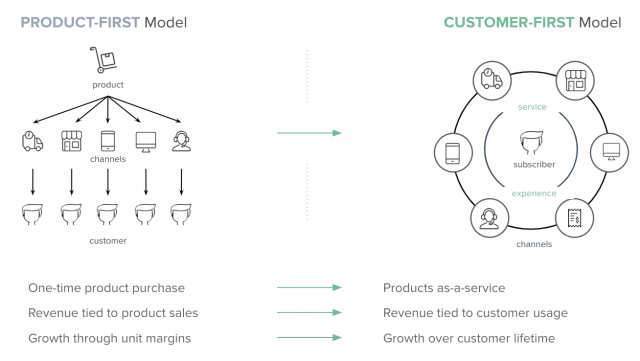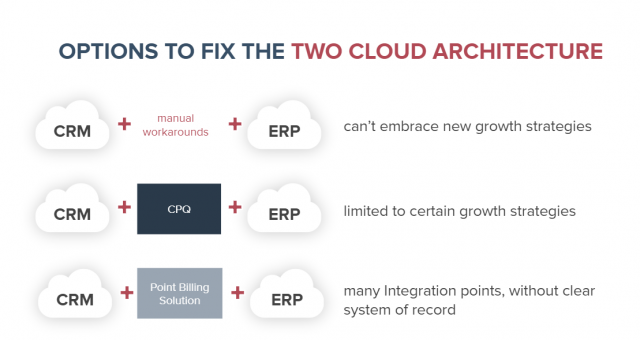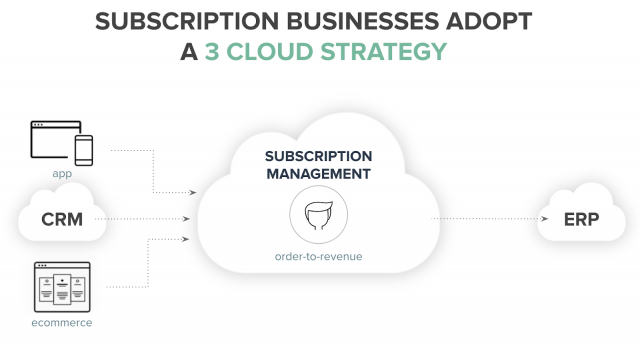What is the role of an IT team? It depends on who you ask.
For 4 out of 10 CIOs, the answer is to “add value to the organization through exceptional operational performance.” Put another way, to keep the lights on.
On the other hand, there is a growing number of CIOs who see their role as more strategic. It’s their responsibility to enable the company on the latest and greatest technology, as well as drive broader business growth strategies. As Deloitte notes “When companies are growing quickly, their organization likely needs a business co-creator in the CIO role.”
But what happens when one of those corporate growth strategies is to adopt a subscription business model? This is an area where IT can play a leading role— but it’s also where things can get tricky.
A Subscription Business Model Impacts IT
Let’s start with what is different about a subscription business model before we jump into what has to be different about the technology to enable it.
A subscription model focuses on recurring customer relationships rather than one-time product sales. In other words, subscription companies adopt a “customer-first” mindset rather than a “product-first” mindset. They are focused on providing products as a service to customers, on creating long lasting customer relationships, and on driving growth throughout the entire customer lifetime. They can’t rely on creating hit products anymore, these companies need to constantly provide value to their customers through ongoing services.

So, to succeed with a subscription business model, IT leaders need to rethink their systems to build a “customer-first” architecture that optimizes for this business model.
Why CRM and ERP Are Not Enough
Now let’s look at the typical technology architecture.
While there are dozens, if not hundreds, of applications in every company, there is always a similar set of tools that enable the “quote-to-revenue” process (also known as quote-to-cash or quote-to-cash)—the process that lets your company sell to customers, capture payments, and make money. It’s the backbone of any business.
Most companies today anchor the quote-to-revenue process on a two-cloud architecture—a Customer Relationship Management system (CRM) and an Enterprise Resource Planning system (ERP).

But here’s the thing: stitching together a CRM and ERP does not work for the dynamic nature of a subscription model, so the fix is a bottomless pit of hard code and customizations.
Why? Let me net it down to three reasons:
- It’s too hard to monetize a product “as-a-service” in a two-cloud architecture. CRM and ERPs were built in the era of selling products, so everything rests on the concept of a SKU (stock keeping unit). But that’s not how a subscription business works. Subscription companies monetize products “as a service” through a variety of pricing strategies—different editions, usage-based pricing, tiered pricing, overages, recurring billing, and more. If your company tries to retrofit these strategies into a SKU-based two-cloud architecture, you will inevitably need hard-coded customizations and mountains of custom logic. If you want to add an annual subscription offering in addition to the monthly subscription, that’s a hard-coded customization. If you want to monetize a product by number of users, that’s a hard-coded customization. CRM and ERPs cannot support these pricing strategies out of the box so Apex, Suitescript, and hard-coded options become the only answer.
- Evolving the go-to-market strategy leads to more hard code and customizations every time. After initial launch, plans to expand internationally, add a second product line, focus on upsells, and more are all common strategies to sustain growth. The problem is, every new strategy requires the IT team to rewrite hard-coded logic. That’s because CRM and ERP solutions are not built to support the complexities of subscription processes nor to easily pass information between the two systems. If your company is planning to launch a second subscription product, you’ll need to hard code those offerings and downstream financial rules. If your company wants to offer annual subscriptions in addition to monthly ones, you’ll need to hard code the new billing cadence (not to mention proration rules and how to handle customers who upgrade from monthly to annual). If your company wants to adopt a new CPQ solution for the sales team, you’ll need to hard code the integration points to connect CPQ to your billing and back-office systems. And all of that changes again when a new go-to-market strategy emerges. You get the gist.
- Giving customers the flexibility to change their subscription after sign-up leads to added customizations—and finance headaches. We find that 70% of a subscription company’s revenue comes from existing customers through upsells, add-ons, and renewals. That’s why companies that let their customers make changes to a subscription after sign-up see greater growth. In fact, according to the latest Subscription Economy Index (SEI), for companies that average one change for every single subscription, the growth rate almost triples from the baseline to 28% YoY growth. That’s especially true for B2B companies, where the strategy is often to land with a smaller product footprint and let the customer value expand over time. Our own data shows us that B2B companies see four changes to their subscription every single year on average. But how do you support all of these change scenarios? What if the customer wants to add another product? What if they want to upgrade to a different usage tier? What if they want to pause the subscription? What if they want to renew earlier? What if, what if, what if?
For every single possible scenario, your IT team will need to hard code a solution to anticipate the downstream impacts on order management, billing, collections, revenue recognition, and reporting. It’s an endless uphill battle. Most companies recognize this, and end up putting the burden on their finance teams—asking Accounts Receivable and Revenue Accounting teams to essentially handle every scenario as a manual one-off. Needless to say, if your company is planning to grow, that’s not sustainable.
Working Around the Broken Two-Cloud Architecture
Over the course of our work with over a thousand subscription companies, the pattern has become clear—a two-cloud architecture inevitably forces companies down the path of hard-coded customizations.
As IT teams realize this, we’ve seen some creative workarounds—that put pressure on Finance…and ultimately fail:

These are the three most common paths IT takes with Finance:
- “It’s better to have manual workarounds than a hard-coded mess.” Some companies such as Symantec and eMoney ask their finance departments to take on the burden. Every new customer order is manual, every invoice change is manual, every revenue contract modification is manual. While this is manageable for a small company with ~30 customers, it’s not manageable as companies grow. The customer experience also takes a hit in this scenario. Sheila Jordan, the CIO at Symantec, said that at one point Symantec took 21 days simply to provision software that a customer ordered, due to the complexity of their manual process.
- “It’s better to have a CPQ than nothing.” There’s a misconception that CPQ fixes everything. On the contrary, a CPQ is simply a channel for your assisted sales team to create quotes. After a quote gets created, that quote is tossed over the wall to the finance team, who has to deal with the downstream quote-to-revenue mess. When companies sell through multiple channels, it’s cleaner to streamline all orders through one system rather than make exceptions for a CPQ. This was the situation at Carbonite. Irwin Weiss, VP Information Technology at Carbonite said: “Our legacy financial processes were disconnected and labor intensive … ultimately our goal is to migrate all of our order transactions through [one system], regardless of whether it’s for consumer or business, and regardless of channel: direct, reseller, MSP. We want all transactions flowing through the same financial back-end.”
- “It’s better for engineering to build a simple billing solution than have nothing.” Most commonly, companies just want a quick fix—so companies buy a simple recurring billing engine or ask engineering to build a homegrown billing solution. That works if you’re selling a $9.99 subscription, but it immediately breaks when a company’s go-to-market strategy starts to evolve. Why? Because there is a whole set of unknowns across the quote-to-revenue process—dependencies that aren’t solved with a simple point billing solution. Servcorp experienced this problem: “Previously, when someone in the business had come up with a new way to price or wanted to run a new promotion,” explains Chief Operating Officer Matthew Baumgartner, “that was a conversation between myself and a technology head—and that consumed a whole bunch of resources and time.”
Successful Subscription Companies Have a Three-Cloud Strategy
It’s important for IT teams to think about the architecture that enables long-term growth rather than a short-term win. The right decision will solve the issue of the IT team being a bottleneck to the overall business strategy.
Instead of retrofitting a new subscription business model into a legacy architecture, IT teams that we work with have found a better solution.
Because of the dynamic nature of subscriptions, subscription businesses need to adopt a three-cloud architecture strategy with:
- CRM/eCommerce as the acquisition channel
- ERP as the General Ledger
- And an end-to-end subscription management solution in the middle

The subscription management solution is responsible for all quote-to-revenue operations, enabling you to price, rate, bill, collect, recognize, measure, acquire, and nurture your subscribers.
The New IT: Business Heroes and Drivers of Growth
5-10 minutes.
That’s how long it now takes Symantec to process 80% of orders—without workarounds, without bespoke back-end systems, without manual processes, without complications. As the company transitioned from a traditional product company with a very complex IT system to a subscription company, its underlying systems and processes had to change as well.
According to Sheila Jordan, CIO for Symantec, “We were looking at where the future was going and we saw that the future is SaaS.” So Symantec made the decision to consolidate their complex IT ecosystem into one platform and make the transition into a security-as-a-service provider.
At the heart of this transition: Zuora. As Jordan notes, “You call Zuora the hub. I call Zuora the heart. It’s the heart of the platform because it holds all the intelligence around the billing and the subscriptions—it’s the heart that ties it together.”
Now with a three-cloud architecture at the center of its tech stack, Symantec has been able to simplify their complex quote-to-revenue processes. Whereas Symantec used to have long provisioning times (as I noted above, one legacy product took a full 21 days to book), now 80% of their orders that are running on their global subscription platform are provisioned in just 5-10 minutes. And in FY17, Symantec experienced 28% YoY growth growth in GAAP revenue and 35% growth in non-GAAP revenue.
That’s what it looks like when businesses have a three-cloud strategy.
When IT can help business units across the organization to do their jobs better, more easily, and faster, they become heroes. When IT is instrumental in architecting a new stack to solve for the dynamic quote-to-revenue process, they cease to be merely order takers and ticket fixers. They become drivers for growth and valued strategic business partners.
IT Function: Architect for Growth
Because the way we do business has fundamentally changed, the IT function has to change as well.
The new quote-to-revenue process doesn’t just usher in a whole new way of doing business and a whole new set of systems—it ushers in the dawn of a “New IT.” No longer is IT a closed off G&A department. Modern IT marries business and technology, with the IT function playing a pivotal role in driving change and enabling new revenue streams.
Business leaders are demanding that IT enable the transition from product-based companies to recurring revenue models. Marketing & Sales looks to IT to compete in the market and be strategically positioned to launch new products and services, provide new ways to price and package, and identify upsell and cross sell opportunities. Finance looks to IT to provide growth metrics and a new financial model for subscription businesses.
In other words, the time has passed for technology leaders to focus their efforts on simply maintaining legacy systems. Working cross-functionally, technology business leaders need to break down silos across the organization and drive the alignment that is necessary to transform a business. Now is the time to take bold steps towards an innovative IT architecture and help architect your company’s newfound growth.